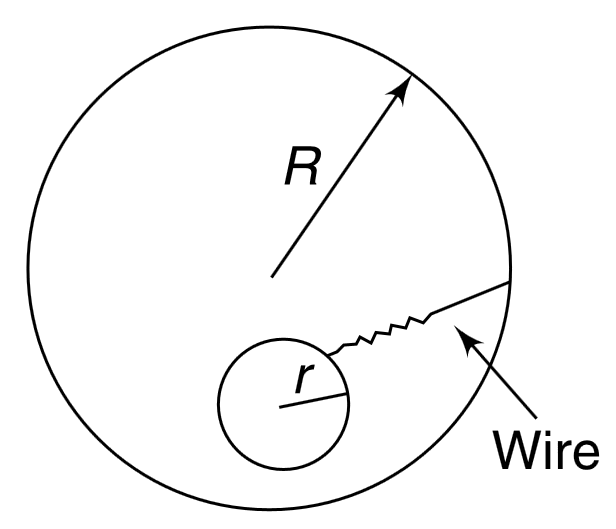Paragraph for Questions 53 and 54: An isolated system consists of two conducting spheres A and B. Sphere A has five times the radius of sphere B. Initially, the spheres are given equal amounts of positive charge and are isolated from each other. The two spheres are then connected by a conducting wire.
Note: The potential of a sphere of radius R that carries a charge Q is V=kQ/R, if the potential at infinity is zero.
Which one of the following statements is true after the spheres are connected by the wire?
The electric potential of A is 1/25 as large as that of B.
The electric potential of A equals that of B.
The electric potential of A is 25 times larger than that of B.
The electric potential of A is 1/5 as large as that of B.
The correct Answer is:B
Topper's Solved these Questions
- ELECTRIC POTENTIALBOOK - RESNICK AND HALLIDAYCHAPTER - ELECTRIC POTENTIALEXERCISE - (PRACTICE QUESTIONS) Matrix-Match
4 Videos
- ELECTRIC POTENTIALBOOK - RESNICK AND HALLIDAYCHAPTER - ELECTRIC POTENTIALEXERCISE - (PRACTICE QUESTIONS) Integer Type
1 Videos
- ELECTRIC POTENTIALBOOK - RESNICK AND HALLIDAYCHAPTER - ELECTRIC POTENTIALEXERCISE - (PRACTICE QUESTIONS) More than One Correct Choice Type
8 Videos
- ELECTRIC CHARGES AND FIELDSBOOK - RESNICK AND HALLIDAYCHAPTER - ELECTRIC CHARGES AND FIELDSEXERCISE - Practice Questions (Integer Type )
3 Videos
- ELECTROMAGNETIC INDUCTIONBOOK - RESNICK AND HALLIDAYCHAPTER - ELECTROMAGNETIC INDUCTIONEXERCISE - PRACTICE QUESTIONS (Integer Type)
14 Videos
Similar Questions
A conducting sphere of radius r has a charge . Then .
View Solution
A conducting ball of radius r is charged to a potential V0. It is enveloped by a thin walled conducting sphere of radius R (gt r) and the two spheres are connected by a conducting wire. Find the potential of the outer sphere.
View Solution
Knowledge Check
Paragraph for Questions 53 and 54: An isolated system consists of two conducting spheres A and B. Sphere A has five times the radius of sphere B. Initially, the spheres are given equal amounts of positive charge and are isolated from each other. The two spheres are then connected by a conducting wire.
Note: The potential of a sphere of radius R that carries a charge Q is V=kQ/R, if the potential at infinity is zero.
Determine the ratio of the charge on sphere A to that on sphere B,qA/qB, after the spheres are connected by the wire.A1B1/5C5D25A conducting sphere of radius r has a charge . Then .
Athe charge is uniformly distributed over its surface if there is an external electric field .BDistribution of charge over its surface will be non uniform if no external electric field exist in space,CElectric field strength inside the sphere will be equal to zero only when no external electric field existsDPotential at every point of the sphere must be sameThe capacitance of an isolated conducting sphere of radius R is proportional to
A4πε0rB2πε0rCπε0rD8πε0r
Self energy of conducting sphere of radius .r. carrying charge .Q. is ______
View SolutionA conducting sphere of radius R and carrying a charge Q is joined to an uncharged conducting sphere of radius 2R. The charge flowing between them will be
View SolutionA metal sphere A of radius a is charged to potential V. What will be its potential if it is enclosed by a spherical conducting shell B of radius b and the two are connected by a wire ?
View SolutionA metal sphere A of radius a is charged to potential V. What will be its potential if it is enclosed ny a spherical conducting shell B of radius b and the two are connected by a wire ?
View SolutionA conducting sphere of radius R and carrying a charge Q is joined to an uncharged conducting sphere of radius 2R. The charge flowing between them will be
View Solution
